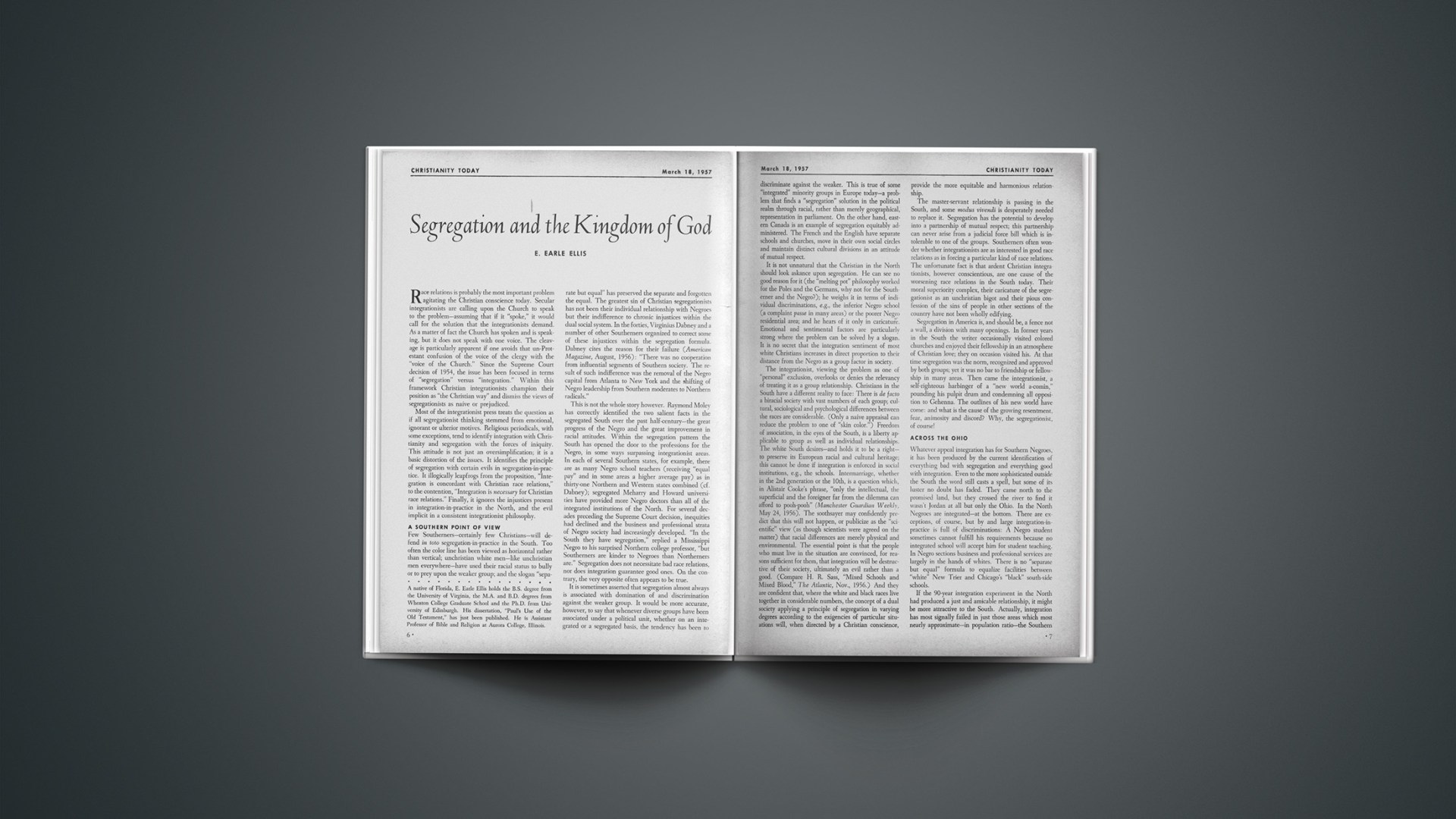Race relations is probably the most important problem agitating the Christian conscience today. Secular integrationists are calling upon the Church to speak to the problem—assuming that if it “spoke,” it would call for the solution that the integrationists demand. As a matter of fact the Church has spoken and is speaking, but it does not speak with one voice. The cleavage is particularly apparent if one avoids that un-Protestant confusion of the voice of the clergy with the “voice of the Church.” Since the Supreme Court decision of 1954, the issue has been focused in terms of “segregation” versus “integration.” Within this framework Christian integrationists champion their position as “the Christian way” and dismiss the views of segregationists as naive or prejudiced.
Most of the integrationist press treats the question as if all segregationist thinking stemmed from emotional, ignorant or ulterior motives. Religious periodicals, with some exceptions, tend to identify integration with Christianity and segregation with the forces of iniquity. This attitude is not just an oversimplification; it is a basic distortion of the issues. It identifies the principle of segregation with certain evils in segregation-in-practice. It illogically leapfrogs from the proposition, “Integration is concordant with Christian race relations,” to the contention, “Integration is necessary for Christian race relations.” Finally, it ignores the injustices present in integration-in-practice in the North, and the evil implicit in a consistent integrationist philosophy.
A Southern Point Of View
Few Southerners—certainly few Christians—will defend in toto segregation-in-practice in the South. Too often the color line has been viewed as horizontal rather than vertical; unchristian white men—like unchristian men everywhere—have used their racial status to bully or to prey upon the weaker group; and the slogan “separate but equal” has preserved the separate and forgotten the equal. The greatest sin of Christian segregationists has not been their individual relationship with Negroes but their indifference to chronic injustices within the dual social system. In the forties, Virginius Dabney and a number of other Southerners organized to correct some of these injustices within the segregation formula. Dabney cites the reason for their failure (American Magazine, August, 1956): “There was no cooperation from influential segments of Southern society. The result of such indifference was the removal of the Negro capital from Atlanta to New York and the shifting of Negro leadership from Southern moderates to Northern radicals.”
This is not the whole story however. Raymond Moley has correctly identified the two salient facts in the segregated South over the past half-century—the great progress of the Negro and the great improvement in racial attitudes. Within the segregation pattern the South has opened the door to the professions for the Negro, in some ways surpassing integrationist areas. In each of several Southern states, for example, there are as many Negro school teachers (receiving “equal pay” and in some areas a higher average pay) as in thirty-one Northern and Western states combined (cf. Dabney); segregated Meharry and Howard universities have provided more Negro doctors than all of the integrated institutions of the North. For several decades preceding the Supreme Court decision, inequities had declined and the business and professional strata of Negro society had increasingly developed. “In the South they have segregation,” replied a Mississippi Negro to his surprised Northern college professor, “but Southerners are kinder to Negroes than Northerners are.” Segregation does not necessitate bad race relations, nor does integration guarantee good ones. On the contrary, the very opposite often appears to be true.
It is sometimes asserted that segregation almost always is associated with domination of and discrimination against the weaker group. It would be more accurate, however, to say that whenever diverse groups have been associated under a political unit, whether on an integrated or a segregated basis, the tendency has been to discriminate against the weaker. This is true of some “integrated” minority groups in Europe today—a problem that finds a “segregation” solution in the political realm through racial, rather than merely geographical, representation in parliament. On the other hand, eastern Canada is an example of segregation equitably administered. The French and the English have separate schools and churches, move in their own social circles and maintain distinct cultural divisions in an attitude of mutual respect.
It is not unnatural that the Christian in the North should look askance upon segregation. He can see no good reason for it (the “melting pot” philosophy worked for the Poles and the Germans, why not for the Southerner and the Negro?); he weighs it in terms of individual discriminations, e.g., the inferior Negro school (a complaint passe in many areas) or the poorer Negro residential area; and he hears of it only in caricature. Emotional and sentimental factors are particularly strong where the problem can be solved by a slogan. It is no secret that the integration sentiment of most white Christians increases in direct proportion to their distance from the Negro as a group factor in society.
The integrationist, viewing the problem as one of “personal” exclusion, overlooks or denies the relevancy of treating it as a group relationship. Christians in the South have a different reality to face: There is de facto a biracial society with vast numbers of each group; cultural, sociological and psychological differences between the races are considerable. (Only a naive appraisal can reduce the problem to one of “skin color.”) Freedom of association, in the eyes of the South, is a liberty applicable to group as well as individual relationships. The white South desires—and holds it to be a right—to preserve its European racial and cultural heritage; this cannot be done if integration is enforced in social institutions, e.g., the schools. Intermarriage, whether in the 2nd generation or the 10th, is a question which, in Alistair Cooke’s phrase, “only the intellectual, the superficial and the foreigner far from the dilemma can afford to pooh-pooh” (Manchester Guardian Weekly, May 24, 1956). The soothsayer may confidently predict that this will not happen, or publicize as the “scientific” view (as though scientists were agreed on the matter) that racial differences are merely physical and environmental. The essential point is that the people who must live in the situation are convinced, for reasons sufficient for them, that integration will be destructive of their society, ultimately an evil rather than a good. (Compare H. R. Sass, “Mixed Schools and Mixed Blood,” The Atlantic, Nov., 1956.) And they are confident that, where the white and black races live together in considerable numbers, the concept of a dual society applying a principle of segregation in varying degrees according to the exigencies of particular situations will, when directed by a Christian conscience, provide the more equitable and harmonious relationship.
The master-servant relationship is passing in the South, and some modus vivendi is desperately needed to replace it. Segregation has the potential to develop into a partnership of mutual respect; this partnership can never arise from a judicial force bill which is intolerable to one of the groups. Southerners often wonder whether integrationists are as interested in good race relations as in forcing a particular kind of race relations. The unfortunate fact is that ardent Christian integrationists, however conscientious, are one cause of the worsening race relations in the South today. Their moral superiority complex, their caricature of the segregationist as an unchristian bigot and their pious confession of the sins of people in other sections of the country have not been wholly edifying.
Segregation in America is, and should be, a fence not a wall, a division with many openings. In former years in the South the writer occasionally visited colored churches and enjoyed their fellowship in an atmosphere of Christian love; they on occasion visited his. At that time segregation was the norm, recognized and approved by both groups; yet it was no bar to friendship or fellow ship in many areas. Then came the integrationist, a self-righteous harbinger of a “new world a-comin,” pounding his pulpit drum and condemning all opposition to Gehenna. The outlines of his new world have come: and what is the cause of the growing resentment, fear, animosity and discord? Why, the segregationist, of course!
Across The Ohio
Whatever appeal integration has for Southern Negroes, it has been produced by the current identification of everything bad with segregation and everything good with integration. Even to the more sophisticated outside the South the word still casts a spell, but some of its luster no doubt has faded. They came north to the promised land, but they crossed the river to find it wasn’t Jordan at all but only the Ohio. In the North Negroes are integrated—at the bottom. There are exceptions, of course, but by and large integration-inpractice is full of discriminations: A Negro student sometimes cannot fulfill his requirements because no integrated school will accept him for student teaching. In Negro sections business and professional services are largely in the hands of whites. There is no “separate but equal” formula to equalize facilities between “white” New Trier and Chicago’s “black” south-side schools.
If the 90-year integration experiment in the North had produced a just and amicable relationship, it might be more attractive to the South. Actually, integration has most signally failed in just those areas which most nearly approximate—in population ratio—the Southern scene. The integrationist “blockbuster” approach is exemplified by Trumbull Park (Chicago) where Negroes were assigned to a white housing project. The result has been riot, race hatred and a 24-hour police guard for more than a year. In nearby Gary, Indiana, Andrew Means, a Negro contractor, using a segregationist approach, has built six Negro suburban-type communities. Race relations are good. Nevertheless, integrationists encounter a mental block at the suggestion that segregation has merit as a pattem-for-living in a multiracial society.
The Southerner can understand the sentimentalist, but the inconsistency of most integrationists is harder to comprehend. In the integrationist North, papers often censor local racial unrest (to prevent riot), then editorialize about immoral segregation in the South. When teaching Sunday School in Chicago’s “black” south side, the writer failed to encounter any homes of Christian integrationists. They live in “white” suburbs, send their children to “white” schools, and then travel through Negro areas to their editorial offices, professions and businesses where they expatiate against segregation. Sometimes they favor admitting a Negro to their suburb if he is the “right kind” of Negro. A Christian friend of the writer, quite integration-conscious, mentioned having had Negro dinner guests. “Of course,” he added, “they were clean and educated—no one like Isaac (our janitor).” Is this the fulfillment of New Testament ethics?
The point is not that the integrationist would defend integration-in-practice in the North. But in condemning the segregationist’s failure to achieve a “separate and equal” society, the integrationist fails to realize the implication of his own failure to achieve a “mixed and equal” society. This failure hardly recommends integration as “the solution” to racial discrimination and animosity—a goal that both groups seek. If Southern Christian leaders can do no better than to follow the integrationist approach of their brothers to the North, the future is less than bright.
And The Kingdom Of God
Both integrationists and segregationists are extremely eager to quote God as on their side. However, the Scriptures most frequently used, the “curse of Ham” argument in Genesis and the “one blood” argument in Acts, are irrelevant. The New Testament does indeed picture all Christians as being united. In Christ there is neither Jew nor Greek, male nor female, free nor slave, rich nor poor, educated nor ignorant, clean nor dirty, black nor white (cf. Gal. 3:28; Col. 3:11). But in New Testament Christianity this is a unity in diversity, a unity which transcends differences and works within them, but never a unity which ignores or denies differences or necessarily seeks to erase them. The servant is no less a servant, the master no less a master; the rich no less rich, and the poor no less poor. The New Testament ethic is not “we are the same, there is no difference; we are equal, therefore I love you” but rather “we are not the same, we are not equal in many ways; but I love you and desire your good.” The Gospel was not primarily to change the pattern of society, but to bring to bear new motives and new attitudes within the pattern. It is true that Christianity effected changes in the pattern, but its approach was totally different from the integrationist’s philosophy today.
Integration as a moral imperative has its roots in a secular view of the Kingdom of God in which the Kingdom is identified with the church and ultimately with the society of this world, and is to be brought in by social reforms. For the New Testament, however, whatever its manifestation within the Christian community is, the Kingdom of God is never to be identified with or find its consummation in a this-world society. (Compare T. W. Manson, The Teaching of Jesus, p. 134; E. Stauffer, New Testament Theology, p. 196.) Even within the church the differences between individuals and/or groups are not done away. Paul and Barnabas came to the conclusion that in certain circumstances their best unity lay in separation (Acts 15:36–46). Jewish and Gentile Christians differed in many practices, e.g., the observance of the Sabbath and other Old Testament laws (Rom. 14:5, 6; Acts 18:18; 21:23 ff), differences that ultimately resulted in “ecclesiastical” separation. Not only does the Apostle not view these differences as sinful, but he rather insists on the right of the groups to continue in them (Gal. 2:5; Rom. 14). In other words, the unity of Christians does not necessarily mean a physical “togetherness” or organizational conformity; the Kingdom in the church does not negate the church’s relation to the social customs of the world and of the churches: The same Paul who said that there was neither male nor female in Christ also instructed women to be silent in church (cf. 1 Cor. 11:4; 14:34).
The creed of consistent integrationist Christians could be summed up in the phrase, “the right to belong”; and their heresy, “the refusal to belong.” In their minds “togetherness” is a good, exclusiveness an evil. God—whatever else he is—is certainly “democratic”; segregation is “undemocratic” and therefore immoral.
Only when one applies the philosophy of integration consistently—thankfully most integrationists are not consistent—can he see its full implications. In Christ there is no rich nor poor; therefore, says the economic integrationist, we must integrate society through Christian socialism to eliminate evil class distinctions. It is wrong, cries the political integrationist, to discriminate against a man because of “an accident of birth”—birth in a foreign country; world government and world citizenship are the answers to this wrong. The ecclesiastical integrationist intones: denominations are evil per se, they divide us; we must fulfill Christ’s prayer “that they may be one” by uniting in the “coming great church.” Segregation is discrimination, concludes the racial integrationist, and “de-segregation” is its cure.
The argument for racial integration and the use of governmental force to implement it is a part of a pattern that is very evident in other areas of life. (And how often the voices in the argument vaguely remind one of voices heard at other times, on other issues.) It is a bad argument. Christian communism does not yield a good economic relationship; the “one church” organization does not give true Christian unity; cultural leveling does not produce a common bond of friendship; integration does not alleviate racial animosity and injustice. Further, it is an argument that is ethically anemic: in the name of equality it destroys the liberty of individuals and groups to live and develop in associations of their own preference; in the name of unity it points with undeviating insistence toward authoritarianism and conformity, eschewing the inherent sin root in human society with its inevitable consequence: power corrupts and total power corrupts totally.
If the Kingdom of God as a monolithic homogeneous structure is the goal of Christian ethics—if national, economic, cultural, racial, ecclesiastical distinctions are to be abolished as “immoral,” then the integrationist argument is sound. But if the Kingdom of God is seen as intersecting—and yet above—a this-world framework, compatible with—and yet superseding—the many and varied distinctions in this present age; then segregation is, in principle, an equally valid answer. And in practice it is much more compatible with liberty. Christian integrationists are patently sincere in the path they are forging, but the road signs along that path sometimes remind one more of Aldous Huxley’s Brave New World than of the New Testament’s Kingdom of God.
A native of Florida, E. Earle Ellis holds the B.S. degree from the University of Virginia, the M.A. and B.D. degrees from Wheaton College Graduate School and the Ph.D. from University of Edinburgh. His dissertation, “Paul’s Use of the Old Testament,” has just been published. He is Assistant Professor of Bible and Religion at Aurora College, Illinois.










